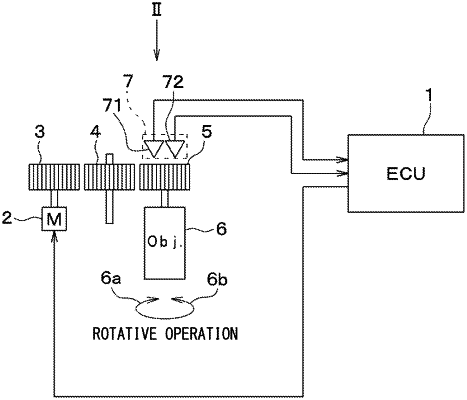| CPC H02P 6/16 (2013.01) [H02K 7/116 (2013.01); H02K 29/08 (2013.01)] | 12 Claims |

|
1. A detection device for identifying a rotation angle of an object rotatable 360° or more comprising:
a sensor outputting a first sensor output that changes according to a change in the rotation angle, and outputting a second sensor output that changes differently from the first sensor output according to a change in the rotation angle;
a target calculation unit calculating a first target angle serving as a target value of a first actual angle corresponding to the first sensor output, and calculating a second target angle serving as a target value of a second actual angle corresponding to the second sensor output; and
a selection unit selecting one of the first sensor output and the second sensor output as a reference destination used for driving the object, wherein
the first sensor output, having a periodicity of 360° with respect to the rotation angle of the object, increases or decreases in a predetermined first normal range as the rotation angle increases within one cycle of own periodicity, and the increase or the decrease of the first sensor output reverses after passing of the rotation angle through a first transition range different from the first normal range,
the second sensor output, having a periodicity of 360° with respect to the rotation angle of the object, increases or decreases in a predetermined second normal range as the rotation angle increases within one cycle of own periodicity, and the increase or the decrease of the second sensor output reverses after passing of the rotation angle through a second transition range, which is different from the second normal range,
the first transition range and the second transition range are separated from each other, and
the selection unit is configured to select the reference destination as a function of: (i) a first angle deviation, which is a difference between the first actual angle and the first target angle, and (ii) a second angle deviation, which is a difference between the second actual angle and the second target angle.
|
|
4. A control device for controlling an actuator that rotates an object rotatable 360° or more comprising:
a sensor outputting a first sensor output that changes according to a change in the rotation angle of the object, and outputting a second sensor output that changes differently from the first sensor output according to a change in the rotation angle of the object;
a target calculation unit calculating a first target angle serving as a target value of a first actual angle corresponding to the first sensor output, and calculating a second target angle serving as a target value of a second actual angle corresponding to the second sensor output;
a selection unit selecting one of the first sensor output and the second sensor output as a reference destination used for driving the object; and
a feedback control unit (i) controlling the actuator so that the rotation angle of the object approaches the first target angle from the first actual angle when the selection unit selects the first sensor output, and (ii) controlling the actuator so that the rotation angle of the object approaches the second target angle from the second actual angle is provided when the selection unit selects the second sensor output, wherein
the first sensor output, having a periodicity of 360° with respect to the rotation angle of the object, increases or decreases in a predetermined first normal range as the rotation angle increases within one cycle of own periodicity, and the increase or the decrease of the first sensor output reverses after passing of the rotation angle through a first transition range different from the first normal range,
the second sensor output, having a periodicity of 360° with respect to the rotation angle of the object, increases or decreases in a predetermined second normal range as the rotation angle increases within one cycle of own periodicity, and the increase or the decrease of the second sensor output reverses after passing of the rotation angle through a second transition range different from the second normal range,
the first transition range and the second transition range are separated from each other, and
the smaller an absolute value of a first angle deviation, which is a difference between the first actual angle and the first target angle, the easier it is configured for the selection unit to select the first sensor output as the reference destination, and the larger an absolute value of the first angle deviation, the easier it is configured for the selection unit to select the second sensor output as the reference destination.
|